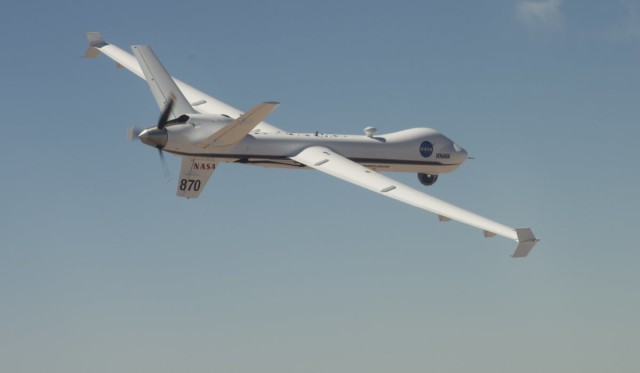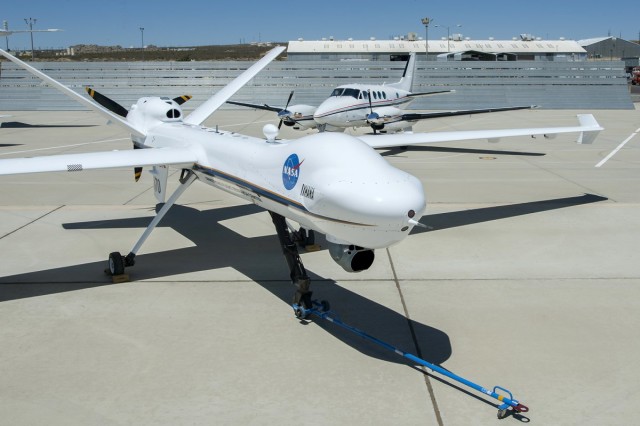
The Ikhana UAS soars over the Mojave Desert during a flight from NASA Armstrong Flight Research Center, Edwards, California.
Credits: NASA Photo / Carla Thomas
Evolving technologies necessary for Unmanned Aircraft Systems (UAS) to safely avoid other aircraft while moving through the nation’s skies recently were put to the test using NASA’s remotely piloted Ikhana aircraft.
Equipped with a prototype system of Detect-and-Avoid (DAA) sensors working in concert with airborne and ground-based computers, Ikhana made 11 flights involving more than 200 scripted encounters with approaching aircraft.
Depending on the specific scenario, either Ikhana detected one or more approaching aircraft and sent an alert to its remote pilot to take action, or Ikhana itself took action on its own by flying a programmed maneuver to avoid a collision – an aviation first.
“We recorded some valuable data that will take some time to analyze fully, and we expect we’ll need to make some minor refinements to our algorithms, but from what we saw during the tests, the results look promising,” said Dennis Hines, NASA’s director for programs for Armstrong Flight Research Center at Edwards, CA.
Staged from Armstrong and flown over the high desert of California, the DAA research was designated FT3, the third in a series of flight test campaigns for NASA’s Unmanned Aircraft Systems Integration in the National Airspace System (UAS-NAS) project.
“The successful completion of this flight test campaign represents the maturity of our detect-and-avoid system,” said Frank Pace, president of Aircraft Systems for General Atomics Aeronautical Systems, Inc.
As a NASA industry partner, the company developed one of the three primary DAA sensors flown on Ikhana, in this case a prototype radar system. It also contributed Ikhana system and self-separation and collision avoidance alerting logic software.
The other two sensors included an Automatic Dependent Surveillance – Broadcast (ADS-B) from BAE Systems, and a second generation Traffic alert and Collision Avoidance System (TCAS) from Honeywell International, Inc.
ADS-B is a satellite-based navigation tool in which an aircraft determines its position and then broadcasts that information, enabling other nearby airplanes equipped with the same tool to know where everyone is at in the sky.
As its name implies, TCAS keeps an electronic eye on the sky immediately surrounding an airplane. Should another airplane with a similar device fly too close, an alert will prompt the pilot to take action.

Honeywell supplied a specially instrumented twin-engine King Air to serve as an intruder for NASA’s Ikhana UAS.
Credits: NASA Photo / Ken Ulbrich
Honeywell also provided software that enabled the three sensors to work together, as well as a specially instrumented aircraft to play the role of an intruder encroaching on Ikhana’s airspace.
“This phase of flight tests, and our ability to meet the challenge of integrating UAS into the NAS, wouldn’t be possible without the strong partnership that exists between NASA and its aeronautical industry partners,” Hines said.
Knowledge gleaned from the data recorded during this third phase of UAS-NAS flight tests not only will help researchers plan the next phase of flight tests – now targeted for next spring – but also will help inform organizations developing UAS-related operating standards.
Source: NASA

In October 2012, R Cubed Engineering (R3E), a small technology company based in Maryland USA, in conjunction with a Canadian team from Memorial University of Newfoundland (MUN) conducted the “aviation first” automatic collision avoidance event between two small Unmanned Aircraft Systems at the former US Navy airfield in Argentia, NF. The AWSAS was directly linked with an ARDU autopilot, and successfully fed a self separation, turning maneuver that resulted in minimum separation of 350 meters in the structured encounter, which was a head-on, co-altitude sequence. Also, in February 2013, at Yuma Proving Ground, Arizona, R3E’s AWSAS, linked directly to the Piccolo autopilot of a Navy Tiger Shark Group 3 UAS, executed multiple, successful, collision avoidance sequences between two Tiger Shark UASs. These automatic collision avoidance events, with no input from the remote pilot, were an “aviation first” between two mid-size UASs, and resulted in minimum horizontal separation between the aircraft of 6000 feet (1 nm) which was programmed into the AWSAS. NASA’s Ikhana may have performed the first automatic collision avoidance for a large UAS against a manned aircraft; but it was not the first time that a programmed maneuver was demonstrated to avoid collision between two aircraft.
AWSAS is All Weather Sense and Avoid System. The US Office of Naval Research funded development of AWSAS starting in 2009. The US Naval Air Systems Command (NAVAIR) provided additional funding for the flight testing at Yuma Proving Ground. The flight testing in Newfoundland was funded in part by the Office of the Secretary of Defense (Defense Safety Oversight Committee – DSOC).